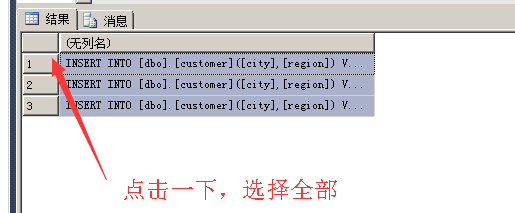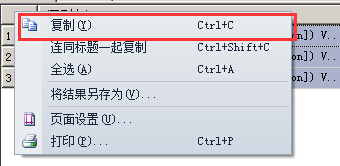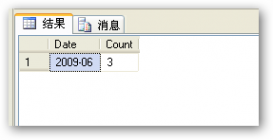有时候,我们需要将某个表里的数据全部或者根据查询条件导出来,迁移到另一个相同结构的库中
目前SQL Server里面是没有相关的工具根据查询条件来生成INSERT语句的,只有借助第三方工具(third party tools)
这种脚本网上也有很多,但是网上的脚本还是欠缺一些规范和功能,例如:我只想导出特定查询条件的数据,网上的脚本都是导出全表数据
如果表很大,对性能会有很大影响
这里有一个存储过程(适用于SQLServer2005 或以上版本)
|
1
2
3
4
5
6
7
8
9
10
11
12
13
14
15
16
17
18
19
20
21
22
23
24
25
26
27
28
29
30
31
32
33
34
35
36
37
38
39
40
41
42
43
44
45
46
47
48
49
50
51
52
53
54
55
56
57
58
59
60
61
62
63
64
65
66
67
68
69
70
71
72
73
74
75
76
77
78
79
80
81
82
83
84
85
86
87
88
89
90
91
92
93
94
95
96
97
98
99
100
101
102
103
104
105
106
107
108
109
110
111
112
113
114
115
116
117
118
119
120
121
122
123
124
125
126
127
128
129
130
131
132
133
134
135
136
137
138
139
140
141
142
143
144
145
146
|
-- Author: <桦仔>-- Blog: <http://www.cnblogs.com/lyhabc/>-- Create date: <//>-- Description: <根据查询条件导出表数据的insert脚本>-- =============================================CREATE PROCEDURE InsertGenerator(@tableName NVARCHAR(MAX),@whereClause NVARCHAR(MAX))AS--Then it includes a cursor to fetch column specific information (column name and the data type thereof) --from information_schema.columns pseudo entity and loop through for building the INSERT and VALUES clauses --of an INSERT DML statement.DECLARE @string NVARCHAR(MAX) --for storing the first half of INSERT statementDECLARE @stringData NVARCHAR(MAX) --for storing the data (VALUES) related statementDECLARE @dataType NVARCHAR(MAX) --data types returned for respective columnsDECLARE @schemaName NVARCHAR(MAX) --schema name returned from sys.schemasDECLARE @schemaNameCount int--shema countDECLARE @QueryString NVARCHAR(MAX) -- provide for the whole query, set @QueryString=' '--如果有多个schema,选择其中一个schemaSELECT @schemaNameCount=COUNT(*)FROM sys.tables tINNER JOIN sys.schemas s ON t.schema_id = s.schema_idWHERE t.name = @tableNameWHILE(@schemaNameCount>)BEGIN--如果有多个schema,依次指定select @schemaName = namefrom(SELECT ROW_NUMBER() over(order by s.schema_id) RowID,s.nameFROM sys.tables tINNER JOIN sys.schemas s ON t.schema_id = s.schema_idWHERE t.name = @tableName) as vwhere RowID=@schemaNameCount--Declare a cursor to retrieve column specific information --for the specified tableDECLARE cursCol CURSOR FAST_FORWARDFORSELECT column_name ,data_typeFROM information_schema.columnsWHERE table_name = @tableNameAND table_schema = @schemaNameOPEN cursColSET @string = 'INSERT INTO [' + @schemaName + '].[' + @tableName + ']('SET @stringData = ''DECLARE @colName NVARCHAR()FETCH NEXT FROM cursCol INTO @colName, @dataTypePRINT @schemaNamePRINT @colNameIF @@fetch_status <> BEGINPRINT 'Table ' + @tableName + ' not found, processing skipped.'CLOSE curscolDEALLOCATE curscolRETURNENDWHILE @@FETCH_STATUS = BEGINIF @dataType IN ( 'varchar', 'char', 'nchar', 'nvarchar' )BEGINSET @stringData = @stringData + '''''''''+isnull(' + @colName + ','''')+'''''',''+'ENDELSEIF @dataType IN ( 'text', 'ntext' ) --if the datatype --is text or something else BEGINSET @stringData = @stringData + '''''''''+isnull(cast(' + @colName + ' as nvarchar(max)),'''')+'''''',''+'ENDELSEIF @dataType = 'money' --because money doesn't get converted --from varchar implicitlyBEGINSET @stringData = @stringData+ '''convert(money,''''''+isnull(cast(' + @colName+ ' as nvarchar(max)),''.'')+''''''),''+'ENDELSEIF @dataType = 'datetime'BEGINSET @stringData = @stringData+ '''convert(datetime,''''''+isnull(cast(' + @colName + ' as nvarchar(max)),'''')+''''''),''+'ENDELSEIF @dataType = 'image'BEGINSET @stringData = @stringData + '''''''''+isnull(cast(convert(varbinary,' + @colName + ') as varchar()),'''')+'''''',''+'ENDELSE --presuming the data type is int,bit,numeric,decimal BEGINSET @stringData = @stringData + '''''''''+isnull(cast(' + @colName + ' as nvarchar(max)),'''')+'''''',''+'ENDSET @string = @string + '[' + @colName + ']' + ','FETCH NEXT FROM cursCol INTO @colName, @dataTypeEND--After both of the clauses are built, the VALUES clause contains a trailing comma which needs to be replaced with a single quote. The prefixed clause will only face removal of the trailing comma.DECLARE @Query NVARCHAR(MAX) -- provide for the whole query, -- you may increase the sizePRINT @whereClauseIF ( @whereClause IS NOT NULLAND @whereClause <> '')BEGIN SET @query = 'SELECT ''' + SUBSTRING(@string, , LEN(@string))+ ') VALUES(''+ ' + SUBSTRING(@stringData, ,LEN(@stringData) - )+ '''+'')''FROM ' +@schemaName+'.'+ @tableName + ' WHERE ' + @whereClausePRINT @query-- EXEC sp_executesql @query --load and run the built query--Eventually, close and de-allocate the cursor created for columns information.ENDELSEBEGIN SET @query = 'SELECT ''' + SUBSTRING(@string, , LEN(@string))+ ') VALUES(''+ ' + SUBSTRING(@stringData, ,LEN(@stringData) - )+ '''+'')''FROM ' + @schemaName+'.'+ @tableNameENDCLOSE cursColDEALLOCATE cursColSET @schemaNameCount=@schemaNameCount-IF(@schemaNameCount=)BEGINSET @QueryString=@QueryString+@queryENDELSEBEGINSET @QueryString=@QueryString+@query+' UNION ALL 'ENDPRINT convert(varchar(max),@schemaNameCount)+'---'+@QueryStringENDEXEC sp_executesql @QueryString --load and run the built query--Eventually, close and de-allocate the cursor created for columns information. |
这里要声明一下,如果你有多个schema,并且每个schema下面都有同一张表,那么脚本只会生成其中一个schema下面的表insert脚本
比如我现在有三个schema,下面都有customer这个表
|
1
2
3
4
5
|
CREATE TABLE dbo.[customer](city int,region int)CREATE SCHEMA testCREATE TABLE test.[customer](city int,region int)CREATE SCHEMA test1CREATE TABLE test1.[customer](city int,region int) |
在执行脚本的时候他只会生成dbo这个schema下面的表insert脚本
|
1
|
INSERT INTO [dbo].[customer]([city],[region]) VALUES('1','2') |
这个脚本有一个缺陷
无论你的表的字段是什麽数据类型,导出来的时候只能是字符
表结构
|
1
|
CREATE TABLE [dbo].[customer](city int,region int) |
导出来的insert脚本
|
1
|
INSERT INTO [dbo].[customer]([city],[region]) VALUES('1','2') |
我这里演示一下怎麽用
有两种方式
1、导全表数据
|
1
|
InsertGenerator 'customer', null |
或
|
1
|
InsertGenerator 'customer', ' ' |

2、根据查询条件导数据
|
1
|
InsertGenerator 'customer', 'city=3' |
或者
|
1
|
InsertGenerator 'customer', 'city=3 and region=8' |

点击一下,选择全部

然后复制

新建一个查询窗口,然后粘贴

其实SQLServer的技巧有很多
最后,大家可以看一下代码,非常简单,如果要支持SQLServer2000,只要改一下代码就可以了
补充:创建一张测试表
|
1
2
3
4
5
6
7
8
9
|
CREATE TABLE testinsert (id INT,name VARCHAR(100),cash MONEY,dtime DATETIME)INSERT INTO [dbo].[testinsert]( [id], [name], [cash], [dtime] )VALUES ( 1, -- id - int'nihao', -- name - varchar(100)8.8, -- cash - moneyGETDATE() -- dtime - datetime)SELECT * FROM [dbo].[testinsert] |
测试
|
1
2
3
|
InsertGenerator 'testinsert' ,''InsertGenerator 'testinsert' ,'name=''nihao'''InsertGenerator 'testinsert' ,'name=''nihao'' and cash=8.8' |
datetime类型会有一些问题
生成的结果会自动帮你转换
|
1
|
INSERT INTO [dbo].[testinsert]([id],[name],[cash],[dtime]) VALUES('1','nihao',convert(money,'8.80'),convert(datetime,'02 8 2015 5:17PM')) |
--------------------------------------------------------------------------------
群里的人共享的另一个脚本
|
1
2
3
4
5
6
7
8
9
10
11
12
13
14
15
16
17
18
19
20
21
22
23
24
25
26
27
28
29
30
31
32
33
34
35
36
37
38
39
40
41
42
43
44
45
46
47
48
49
|
IF OBJECT_ID('spGenInsertSQL','P') IS NOT NULLDROP PROC spGenInsertSQLGOCREATE proc spGenInsertSQL (@tablename varchar(256),@number BIGINT,@whereClause NVARCHAR(MAX))asbegindeclare @sql varchar(8000)declare @sqlValues varchar(8000)set @sql =' ('set @sqlValues = 'values (''+'select @sqlValues = @sqlValues + cols + ' + '','' + ' ,@sql = @sql + '[' + name + '],'from(select casewhen xtype in (48,52,56,59,60,62,104,106,108,122,127) then 'case when '+ name +' is null then ''NULL'' else ' + 'cast('+ name + ' as varchar)'+' end'when xtype in (58,61,40,41,42)then 'case when '+ name +' is null then ''NULL'' else '+''''''''' + ' + 'cast('+ name +' as varchar)'+ '+'''''''''+' end'when xtype in (167)then 'case when '+ name +' is null then ''NULL'' else '+''''''''' + ' + 'replace('+ name+','''''''','''''''''''')' + '+'''''''''+' end'when xtype in (231)then 'case when '+ name +' is null then ''NULL'' else '+'''N'''''' + ' + 'replace('+ name+','''''''','''''''''''')' + '+'''''''''+' end'when xtype in (175)then 'case when '+ name +' is null then ''NULL'' else '+''''''''' + ' + 'cast(replace('+ name+','''''''','''''''''''') as Char(' + cast(length as varchar) + '))+'''''''''+' end'when xtype in (239)then 'case when '+ name +' is null then ''NULL'' else '+'''N'''''' + ' + 'cast(replace('+ name+','''''''','''''''''''') as Char(' + cast(length as varchar) + '))+'''''''''+' end'else '''NULL'''end as Cols,namefrom syscolumns where id = object_id(@tablename)) TIF (@number!=0 AND @number IS NOT NULL)BEGINset @sql ='select top '+ CAST(@number AS VARCHAR(6000))+' ''INSERT INTO ['+ @tablename + ']' + left(@sql,len(@sql)-1)+') ' + left(@sqlValues,len(@sqlValues)-4) + ')'' from '+@tablenameprint @sqlENDELSEBEGINset @sql ='select ''INSERT INTO ['+ @tablename + ']' + left(@sql,len(@sql)-1)+') ' + left(@sqlValues,len(@sqlValues)-4) + ')'' from '+@tablenameprint @sqlENDPRINT @whereClauseIF ( @whereClause IS NOT NULL AND @whereClause <> '')BEGINset @sql =@sql+' where '+@whereClauseprint @sqlENDexec (@sql)endGO |
调用示例
|
1
2
3
4
5
6
7
8
9
10
11
12
|
--非dbo默认架构需注意--支持数据类型 :bigint,int, bit,char,datetime,date,time,decimal,money, nvarchar(50),tinyint, nvarchar(max),varchar(max),datetime2--调用示例 如果top行或者where条件为空,只需要把参数填上nullspGenInsertSQL 'customer' --表名, 2 --top 行数, 'city=3 and didian=''大连'' ' --where 条件--导出全表 where条件为空spGenInsertSQL 'customer' --表名, null --top 行数,null --where 条件INSERT INTO [Department] ([DepartmentID],[Name],[GroupName],[Company],[ModifiedDate]) values (1,N'售后部',N'销售组',N'中国你好有限公司XX分公司','05 5 2015 5:58PM')INSERT INTO [Department] ([DepartmentID],[Name],[GroupName],[Company],[ModifiedDate]) values (2,N'售后部',N'销售组',N'中国你好有限公司XX分公司','05 5 2015 5:58PM') |
以上所述是本文给大家分享的将表里的数据批量生成INSERT语句的存储过程 增强版,希望大家喜欢。












